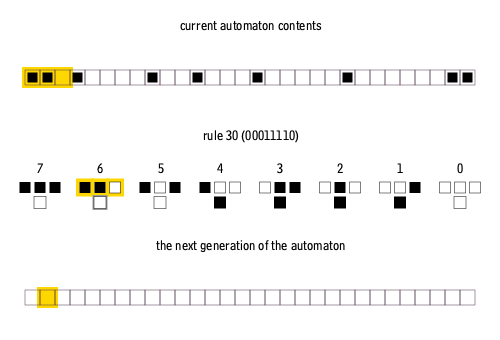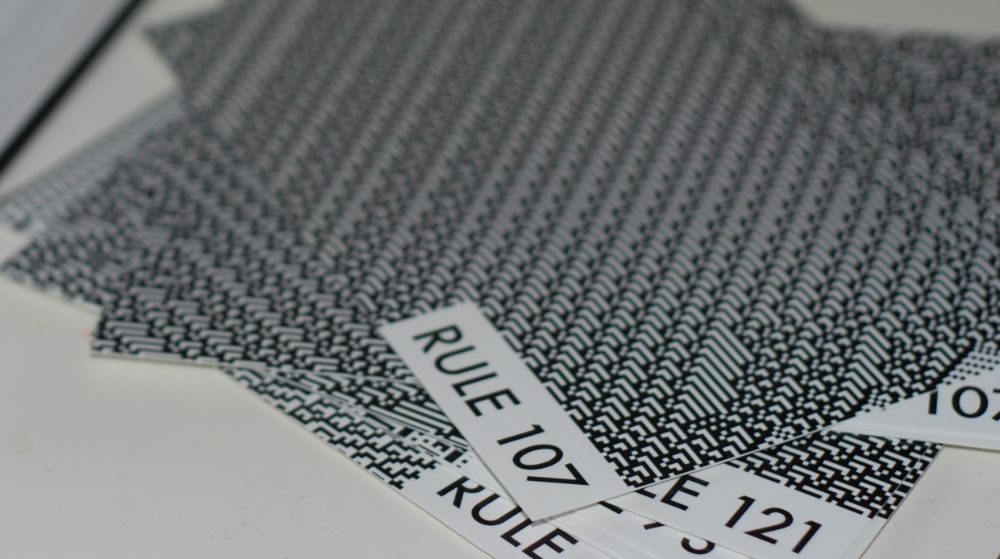Cellular automata is a discrete model of computation studied in automata theory. While it has a binary computer style to the algorithm, it appears many places in nature.
Cellular Automata is usually a grid of squares, where each square can take on a state, usually 1 or 0 or On or Off, but it can be any number of states. What the state of the square is, is determined by the neighboring squares and the input algorithm.
The concept was originally developed in the 01940s by Stanislaw Ulam and John von Neumann. It wasn’t until the 01970s and Conway’s Game of Life, that the subject expanded beyond academia and gained more interest.

As you can see in the animation, each grid square on the next row, is determined by the 3 parents directly above. Following different “rules” those three parents would equate to the state of the child grid square. This process only needs a tiny bit of knolwedge, yet can create vast repeating or complex patterns.
Conway’s Game of Life
The Game of life was created created by John Conway. It is a zero-player game, meaning that its evolution is determined by its initial state, requiring no further input. You start the Game of Life by creating an initial configuration and observing how it evolves. It is Turing complete and can simulate a universal constructor or any other Turing machine.
One way to think about this would be as hungry bits of moss on a rock. Each grid square, or peice of moss, needs room to grow. If that space is occupied, then there is a resource conflict and depending on the next set of neighbors one grid square will live and the other will not.
Sadly, five years ago on April 11th, 02020 John succumbed to COVID symptoms at the age of 82. It is hard to emphasis how important his contribution was to the fields of computer science, physics and biology.
Cellular Automata Fashion
Back in 02015, we backed a Kickstarter project to create cellular automata scarves. We love and still use it to this day. It is made from soft marino wool. Sometimes people ask about the pattern and it is a perfect teaching moment and way to visualize and explain cellular automata.

Taking queues from nature and mathematics is a great way to create art and fashion. It doesn’t have to be boring and ridged.
Cellular Automata Postcards
As a test, we created a series of postcards that used the recipients’ address as the seed into the cellular automata. We used a print-on-demand company (moo.com) to create individual postcards for friends.

Since cellular automata is rule based, we can also use the same input and explore different algorithms (or rules) to create the next step in the process. Here is an example of the same input over 21 different rules. You can see how a simple change can drastically affect the output/design.

The PHP code to generate your own postcards is available on GitHub.
Cellular Seeds
In this crazy world where AI will take all our jobs (or maybe not), being able to recognize and apply an idea is and always has been most important. Do you need to know exactly how Rule 30 compares to Rule 110? Probably not. You can look that up or ask an AI assistant to explain or even write the code for you. The understanding of what Cellular Automata is, where it appears in nature and how you can apply it to your design and projects, has always been more important than which squares light-up when.
If we all go from no-code solutions to vibe coders, we’ll miss all these historical interactions and deeper explorations in computer science.
Take time to smell the proverbial gliders.